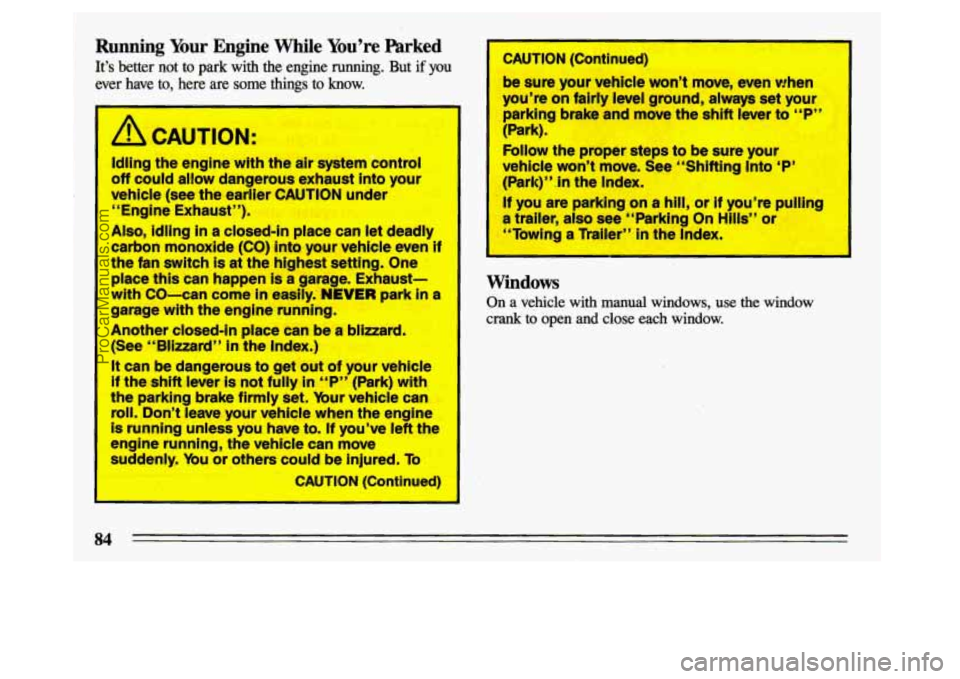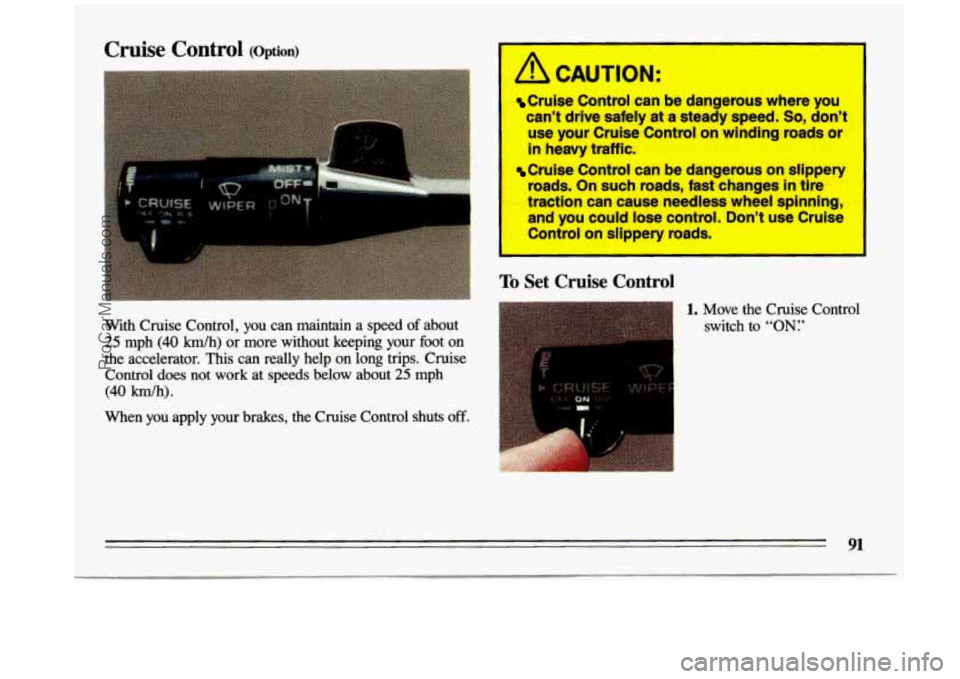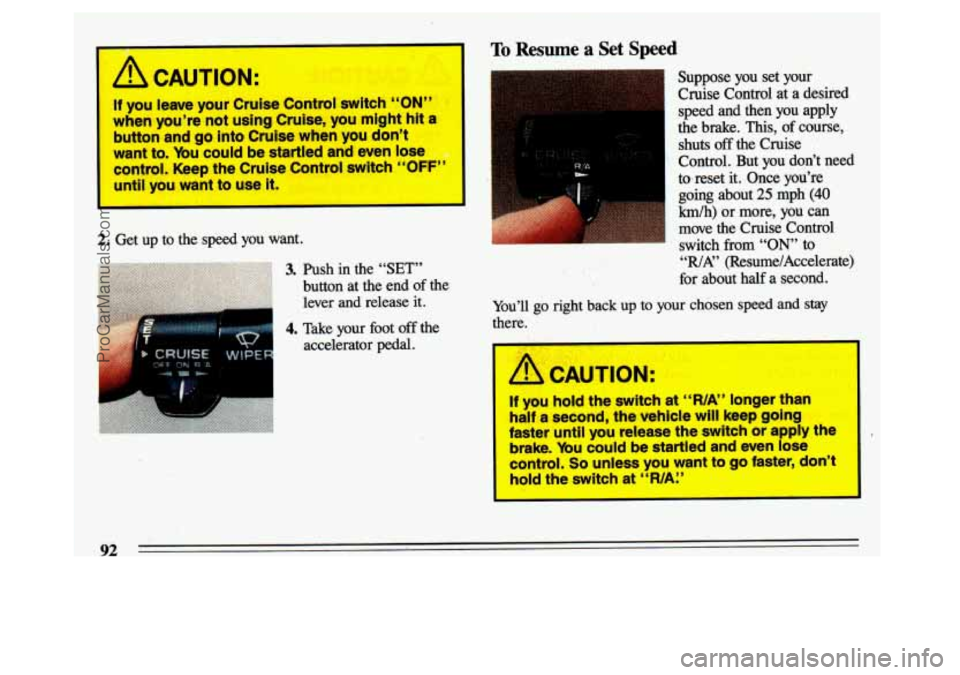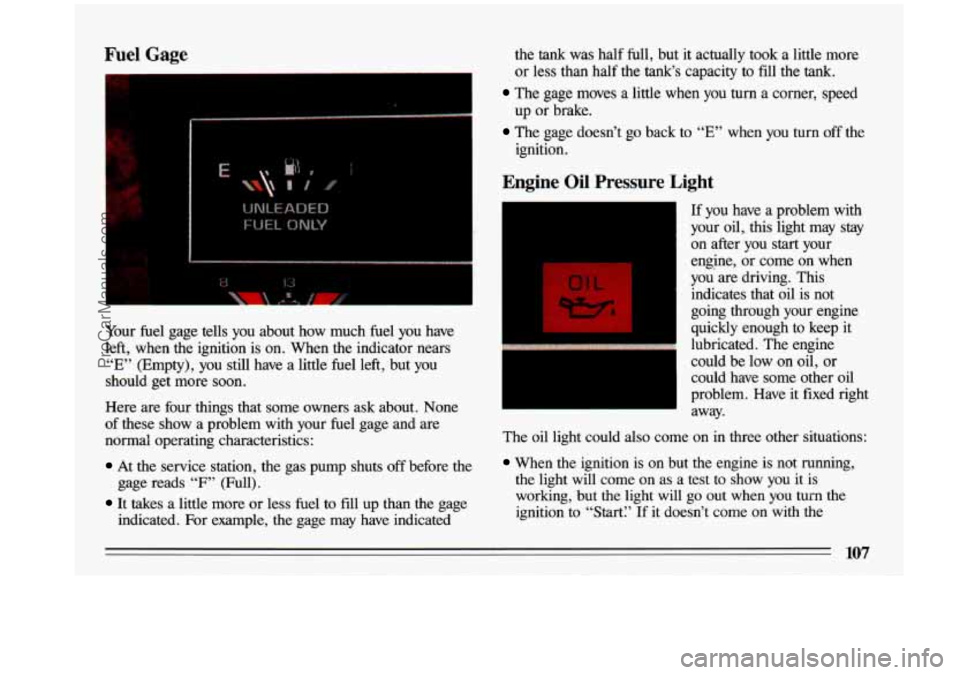1993 BUICK CENTURY brake
[x] Cancel search: brakePage 86 of 324

Running Your Engine While You’re Parked
It’s better not to park with the engine running. But if you
ever have to, here are some things to know.
1
I a CAUTION: I
Idling the engine with the air system “control
off could allow dangerous exhaust into your
vehicle (see the earlier
CAUTION under
“Engine Exhaust”).
Also, idling In a closed-in place can let deadly
carbon monoxide
(CO) into your vehicle even if
the fan switch is at the hlghest setting. One
place this can happen
is a garage. Exhaust-. -
with C0-n come in easily.’ NEVER park in a
garage wlth the engine running.
Another closed-in place can
be a blizzard.
It can be dpngeroua to get out of your vehicle
If the shift lever is not fully On “P” (Park) wlth
the parking
brake firmly set. bur vehicle can
roll. Don’t leave your vehicle when the engine
Os runnhg unless you. have to. If you’ve left the
engine running, the vehicle can move
suddenly.
Nu or others could be injured. To
I
I
I (See “Blizzard” In.the Index.)
CAUTION (Continued)
- - - -
I CAUTION (C __ ____ Jued) ..
be sureyour vehicle won’t move, even when
you’re on fairly level ground, always set your
parking
brake and move the shift lever to “P”,
(Park).
Follow the proper steps to be &re your
vehicle won’t move.
See “Shifting Into ‘P’
(Park)”.in the Index.
If you are parking on
a hill, or if you’re pulling
a trailer, also see “Parking On Hills” or
“Towing
a Thiler” in the Index.
i
Windows
On a vehicle with manual windows, use the window
crank
to open and close each window.
84
ProCarManuals.com
Page 93 of 324

Cruise Control (option)
. .
- ~ "IWC.
. .. -
With Cruise Control, you can maintain a speed of about
25 mph (40 Wh) or more without keeping your foot on
the accelerator.
This can really help on long trips. Cruise
Control does not
work at speeds below about 25 mph
(40 Wh).
When you apply your brakes, the Cruise Control shuts
off.
A CAUTION:
Cruise Control can be dangerous where you
can't drive safely
at a steady speed. So, don't
use your Cruise Control on winding roads or
in heavy traffic.
Cruise Control can be dangerous on slippery
roads.
On such roads, fast changes in tire
traction can cause needless wheel spinning,
and you could lose control. Don't use Cruise
Control on slippery roads.
To Set Cruise Control
1. Move the Cruise Control
switch
to "ON?
91
ProCarManuals.com
Page 94 of 324

rn 1 To Resume a Set Speed
A CAUTION:
If you leave your Cruise Control switch “ON”
when you’re not using Cruise, you might hit a
button and go into Cruise when you don’t
want to. You could be startled
and even lose
control. Keep the Cruise Control switch
“OFF”
~ until you want to use it.
2. Get up to the speed you want.
P
3. Push in the “SET”
button at the end of the
lever and release it.
4. Take your foot off the
accelerator pedal. Suppose you set your
Cruise Control at a desired
speed and then you apply
the brake.
This, of course,
shuts
off the Cruise
Control. But you don’t need
to.reset it. Once you’re
going about 25 mph (40
h/h) or more, you can
move the Cruise Control
switch. from
“ON” to
“WA” (Resume/Accelerate)
for about
half a second.
You’ll
go right back up to your chosen speed and stay
there.
If you hold the switch at “WA” longer than
half a second, the vehicle will keep going
faster
until you release the switch or apply the ,
brake. You could be startled and even lose
control.
So unless you want to go faster, don’t
hold the switch at
“R/AI’ i
92
ProCarManuals.com
Page 96 of 324

Passing Another Vehicle While Using Cruise Control
Use the accelerator pedal to increase your speed. When
you take your foot
off the pedal, your vehicle will slow
down
to the Cruise Control speed you set earlier.
Using Cruise Control on Hills
How well your Cruise Control will work on hills
depends upon your speed, load, and the steepness
of the
hills. When going up steep hills, you may have
to step on
the accelerator
pedal to maintain your speed. When going
downhill, you may have to brake or shift
to a lower gear
to keep your speed down.
Of course, applying the brake
takes you out
of Cruise Control. Many drivers fmd this to
be too much trouble and don’t use Cruise Control on
steep hills.
To Get Out of Cruise Control
L
-.
There are two ways to turn
off the Cruise Control:
Step lightly on the brake
pedal;
OR
Move the Cruise switch
to
“OFF?
To Erase Cruise Speed Memory
When you turn off the Cruise Control or the ignition,
your Cruise Control set speed memory is erased.
94
ProCarManuals.com
Page 98 of 324

Headlight “On” Warning
If you open the door while leaving the lights on, you will
hear a warning chime.
Daytime Running Lights (Canada Only)
The Canadian Federal Government has decided that “Daytime Running Lights” (DRL)
are a useful feature, in
that DIU can make your vehicle more visible to
pedestrians and other drivers during daylight hours. DRL
are required on new vehicles sold in Canada.
Your DRL work with a light sensor on top
of the
instrument panel. Don’t cover it up. The low beam
headlights will come on at reduced brightness
in daylight
when:
The ignition is on
The headlight switch is off, and
The parking brake is released.
At dusk, the exterior. lights will come bn &.nomatically
and the low
beams will change to full brightness. At
dawn, the exterior lights will go out and the low beams
will change to
the reduced brightness of DRL (if the
headlight switch is off).
Of course, you may still turn on the headlights any time
you need to.
To idle your vehicle with DRL off, set the parking brake
while the ignition is in the
“Off’ or “Lock” position.
Then start the vehicle. The
DRL will stay off until you
release the parking brake.
Map Light
& Press the switch to turn the
map light on and
off.
MAP
ON
OFF
96
ProCarManuals.com
Page 109 of 324

Fuel Gage
Your fuel gage tells you about how much fuel you have
left, when the ignition is on. When the indicator nears
“E” (Empty), you still have a little fuel left, but you
should get more
soon.
Here are four things that some owners ask about. None
of these show a problem with your fuel gage and are
normal operating characteristics:
At the service station, the gas pump shuts off before the
gage reads
“F” (Full).
It takes a little more or less fuel to fill up than the gage
indicated. For example, the gage may have indicated the tank was half
full, but it actually took
a little more
or less than half the
tank‘s capacity to fill the tank.
The gage moves a little when you turn a corner, speed
up or brake.
The gage doesn’t go back to “E” when you turn off the
ignition.
Engine Oil Pressure Light
If you have a problem with
your
oil, this light may stay
on after you start your
engine, or come on when
you are driving.
This
indicates that oil is not
going through your engine
quickly enough to keep it
lubricated. The engine could be low on oil, or
could have some other oil
problem. Have it fixed right
away.
The
oil light could also come on in three other situations:
When the ignition is on but the engine is not funning,
the light will come on as a test to show you it is
working, but the light will go out when
you turn the
ignition to “Start? If it doesn’t come on with the
107
ProCarManuals.com
Page 111 of 324

Volts Gage (Option)
When your engine is not
running, but
the ignition is
on (in the “Run” position),
the gage shows your
battery’s state of charge
in
DC volts. When the engine
is running, the gage shows
the condition of the
charging system. Readings
between the red warning
zones indicate the normal
operating range.
Readings in either red
warning zone indicate a possible problem in the electrical
system. Have your vehicle serviced immediately.
Brake System Warning Light
Your Buick‘s hydraulic
brake system is divided into
two parts. If one part isn’t working, the other part can still work and stop you. For
good braking, though, you
need both parts working
well.
If the warning light
goes on, there could be a
brake problem. Have your
brake system inspected right away.
This light should come on
as you start the vehicle. If it doesn’t come on then, have it
fixed
so it will be ready to warn you if there’s a problem.
This light will also come on when you set your parking
brake, and will stay on if your parking brake doesn’t release
fully. If it stays on after your parking brake is
fully released, it means you have a brake problem.
If the light comes on while driving, pull
off the road and
stop carefully.
You may notice that the pedal is harder to
push. Or, the pedal may go closer to -the floor. It may take
longer to stop. If the light is still on, have the vehicle towed
for service. (See “Towing Your Buick” in the Index.)
109
ProCarManuals.com
Page 112 of 324

A CAUTION:
Your brake system may not be working properly
if the brake warning light is on.
Driving with the brake warning light on can
lead to an accident.
If the light is still on after
you’ve pulled
off the road and stopped
carefully, have the vehicle towed
for service.
Engine Coolant Temperature Warning Light
---I
This light tells you that
your engine coolant has
overheated or your radiator
cooling
fan is not working.
If you have been operating
your vehicle under normal
driving conditions, you should pull
off the road,
stop your vehicle and
turn
the engine off as soon as
possible.
HOT COOLANT CAN
BURN YOU BADLY!
In “Problems on the Road:’ this manual shows what to
do. See “Engine Overheating” in the Index.
Engine Coolant Temperature Gage (Option)
‘1 If you have the Gage
Cluster, you have a gage
that shows the engine
coolant temperature.
If the
gage pointer moves into the red area, your engine is too
hot! That reading means the same thing as the warning
light. It means that your engine coolant has
overheated. If you have
been operating your vehicle under normal driving
conditions, you should pull off the road, stop your-
vehicle and
turn off the engine as soon as possible.
Also, the temperature symbol on the gage will come on
when your engine is too hot.
HOT COOLANT CAN BURN YOU BADLY!
In “Problems on the Road:’ this manual shows what to
do. See “Engine Overheating” in the Index.
110
ProCarManuals.com